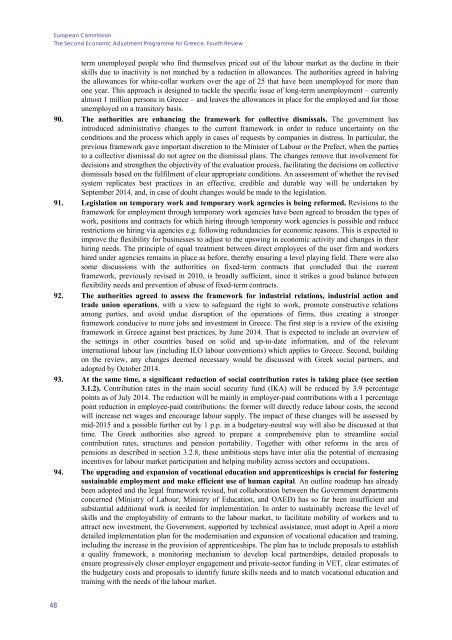ocp192_en
ocp192_en
ocp192_en
You also want an ePaper? Increase the reach of your titles
YUMPU automatically turns print PDFs into web optimized ePapers that Google loves.
European CommissionThe Second Economic Adjustm<strong>en</strong>t Programme for Greece. Fourth Reviewterm unemployed people who find themselves priced out of the labour market as the decline in theirskills due to inactivity is not matched by a reduction in allowances. The authorities agreed in halvingthe allowances for white-collar workers over the age of 25 that have be<strong>en</strong> unemployed for more thanone year. This approach is designed to tackle the specific issue of long-term unemploym<strong>en</strong>t – curr<strong>en</strong>tlyalmost 1 million persons in Greece – and leaves the allowances in place for the employed and for thoseunemployed on a transitory basis.90. The authorities are <strong>en</strong>hancing the framework for collective dismissals. The governm<strong>en</strong>t hasintroduced administrative changes to the curr<strong>en</strong>t framework in order to reduce uncertainty on theconditions and the process which apply in cases of requests by companies in distress. In particular, theprevious framework gave important discretion to the Minister of Labour or the Prefect, wh<strong>en</strong> the partiesto a collective dismissal do not agree on the dismissal plans. The changes remove that involvem<strong>en</strong>t fordecisions and str<strong>en</strong>gth<strong>en</strong> the objectivity of the evaluation process, facilitating the decisions on collectivedismissals based on the fulfilm<strong>en</strong>t of clear appropriate conditions. An assessm<strong>en</strong>t of whether the revisedsystem replicates best practices in an effective, credible and durable way will be undertak<strong>en</strong> bySeptember 2014, and, in case of doubt changes would be made to the legislation.91. Legislation on temporary work and temporary work ag<strong>en</strong>cies is being reformed. Revisions to theframework for employm<strong>en</strong>t through temporary work ag<strong>en</strong>cies have be<strong>en</strong> agreed to broad<strong>en</strong> the types ofwork, positions and contracts for which hiring through temporary work ag<strong>en</strong>cies is possible and reducerestrictions on hiring via ag<strong>en</strong>cies e.g. following redundancies for economic reasons. This is expected toimprove the flexibility for businesses to adjust to the upswing in economic activity and changes in theirhiring needs. The principle of equal treatm<strong>en</strong>t betwe<strong>en</strong> direct employees of the user firm and workershired under ag<strong>en</strong>cies remains in place as before, thereby <strong>en</strong>suring a level playing field. There were alsosome discussions with the authorities on fixed-term contracts that concluded that the curr<strong>en</strong>tframework, previously revised in 2010, is broadly suffici<strong>en</strong>t, since it strikes a good balance betwe<strong>en</strong>flexibility needs and prev<strong>en</strong>tion of abuse of fixed-term contracts.92. The authorities agreed to assess the framework for industrial relations, industrial action andtrade union operations, with a view to safeguard the right to work, promote constructive relationsamong parties, and avoid undue disruption of the operations of firms, thus creating a strongerframework conducive to more jobs and investm<strong>en</strong>t in Greece. The first step is a review of the existingframework in Greece against best practices, by June 2014. That is expected to include an overview ofthe settings in other countries based on solid and up-to-date information, and of the relevantinternational labour law (including ILO labour conv<strong>en</strong>tions) which applies to Greece. Second, buildingon the review, any changes deemed necessary would be discussed with Greek social partners, andadopted by October 2014.93. At the same time, a significant reduction of social contribution rates is taking place (see section3.1.2). Contribution rates in the main social security fund (IKA) will be reduced by 3.9 perc<strong>en</strong>tagepoints as of July 2014. The reduction will be mainly in employer-paid contributions with a 1 perc<strong>en</strong>tagepoint reduction in employee-paid contributions: the former will directly reduce labour costs, the secondwill increase net wages and <strong>en</strong>courage labour supply. The impact of these changes will be assessed bymid-2015 and a possible further cut by 1 p.p. in a budgetary-neutral way will also be discussed at thattime. The Greek authorities also agreed to prepare a compreh<strong>en</strong>sive plan to streamline socialcontribution rates, structures and p<strong>en</strong>sion portability. Together with other reforms in the area ofp<strong>en</strong>sions as described in section 3.2.8, these ambitious steps have inter alia the pot<strong>en</strong>tial of increasinginc<strong>en</strong>tives for labour market participation and helping mobility across sectors and occupations.94. The upgrading and expansion of vocational education and appr<strong>en</strong>ticeships is crucial for fosteringsustainable employm<strong>en</strong>t and make effici<strong>en</strong>t use of human capital. An outline roadmap has alreadybe<strong>en</strong> adopted and the legal framework revised, but collaboration betwe<strong>en</strong> the Governm<strong>en</strong>t departm<strong>en</strong>tsconcerned (Ministry of Labour, Ministry of Education, and OAED) has so far be<strong>en</strong> insuffici<strong>en</strong>t andsubstantial additional work is needed for implem<strong>en</strong>tation. In order to sustainably increase the level ofskills and the employability of <strong>en</strong>trants to the labour market, to facilitate mobility of workers and toattract new investm<strong>en</strong>t, the Governm<strong>en</strong>t, supported by technical assistance, must adopt in April a moredetailed implem<strong>en</strong>tation plan for the modernisation and expansion of vocational education and training,including the increase in the provision of appr<strong>en</strong>ticeships. The plan has to include proposals to establisha quality framework, a monitoring mechanism to develop local partnerships, detailed proposals to<strong>en</strong>sure progressively closer employer <strong>en</strong>gagem<strong>en</strong>t and private-sector funding in VET, clear estimates ofthe budgetary costs and proposals to id<strong>en</strong>tify future skills needs and to match vocational education andtraining with the needs of the labour market.48


